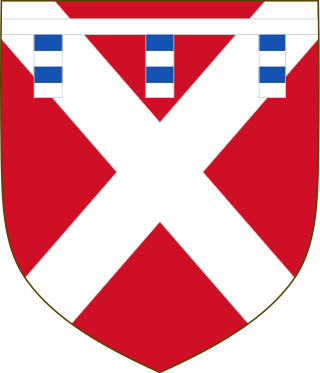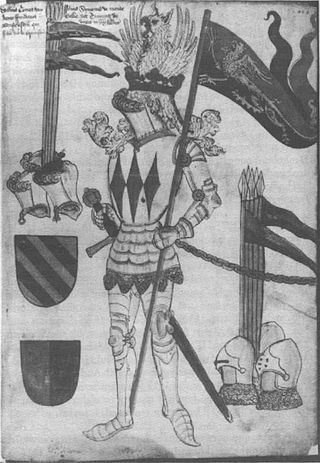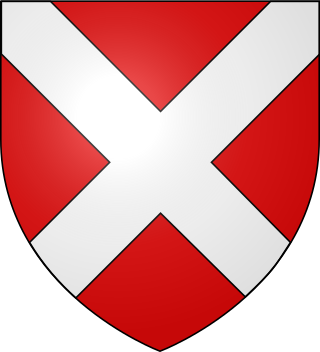
Richard Neville, 5th Earl of Salisbury KG PC was an English nobleman and magnate based in northern England who became a key supporter of the House of York during the early years of the Wars of the Roses. He was the father of Richard Neville, 16th Earl of Warwick, the "Kingmaker".

Earl of Salisbury is a title that has been created several times in English and British history. It has a complex history and is now a subsidiary title to the marquessate of Salisbury.

William Montagu, alias de Montacute, 1st Earl of Salisbury, 3rd Baron Montagu, King of Man was an English nobleman and loyal servant of King Edward III.
Sir Thomas Hoby was an English diplomat and translator.

Bisham is a village and civil parish in the Royal Borough of Windsor and Maidenhead in Berkshire, England. The village is on the River Thames, around one mile (1.6 km) south of Marlow in the neighbouring county of Buckinghamshire, and around three miles (5 km) northwest of Maidenhead. At the 2011 Census, the population of the parish was 1,099, down from 1,149 at the 2001 Census. Bisham is home to one of Sport England's National Sports Centres.
Alice Montacute was an English noblewoman and the suo jure 5th Countess of Salisbury, 6th Baroness Monthermer, and 7th and 4th Baroness Montagu, having succeeded to the titles in 1428.

The titles Baron Montacute or Baron Montagu were created several times in the Peerage of England for members of the House of Montagu. The family name was Latinised to de Monte Acuto, meaning "from the sharp mountain"; the French form is an ancient spelling of mont aigu, with identical meaning.
Maud Francis, Countess of Salisbury was daughter of Sir Adam Francis, born c. 1326, Lord Mayor of London, and Agnes Champnes. She was married and widowed three times. Her first husband was John Aubrey and her second Sir Alan Buxhull, KG in 1372.
Peregrine Hoby, was an English landowner and member of parliament who sat in the House of Commons at various times between 1640 and 1679.
Anne Hoby was an English heiress.

William Montagu, 2nd Baron Montagu, was an English peer, and an eminent soldier and courtier during the reigns of Edward I and Edward II. He played a significant role in the wars in Scotland and Wales, and was appointed steward of the household to Edward II. Perhaps as a result of the influence of his enemy, Thomas, 2nd Earl of Lancaster, Edward II sent him to Gascony as Seneschal in 1318. He died there in October of the following year.
Cecily Neville, Duchess of Warwick, Countess of Worcester was a daughter of Richard Neville, 5th Earl of Salisbury and Alice Montacute, 5th Countess of Salisbury. Her siblings included Richard Neville, 16th Earl of Warwick; John Neville, 1st Marquess of Montagu; George Neville, ; Katherine Neville, Baroness Hastings; and Alice Neville, Baroness FitzHugh.

Eleanor Holland, Countess of Salisbury, was an English noblewoman, the daughter of Thomas Holland, 2nd Earl of Kent, a half-brother of King Richard II of England. She was the first wife of Thomas Montagu, 4th Earl of Salisbury. One of her brothers was Edmund Holland, 4th Earl of Kent, to whom she was co-heiress. She is not to be confused with her eldest sister Alianore Holland, Countess of March who bore the same name.

John Montagu, 3rd Earl of Salisbury and 5th and 2nd Baron Montagu, KG was an English nobleman, one of the few who remained loyal to Richard II after Henry IV became king.

Thomas Montagu, 4th Earl of Salisbury, KG of Bisham in Berkshire, was an English nobleman and one of the most important English commanders during the Hundred Years' War.

The Neville or Nevill family is a noble house of early medieval origin, which was a leading force in English politics in the Late Middle Ages. The family became one of the two major powers in northern England and played a central role in the Wars of the Roses along with their rival, the House of Percy.

The House of Montagu, also known throughout history as Montagud, Montaigu, Montague, Montacute, is an English noble family founded in Somerset after the Norman Conquest of 1066 by the Norman warrior Drogo de Montagud. They rose to their highest power and prominence in the 14th and 15th centuries as Earls of Salisbury, the last in the male line being Thomas Montagu, 4th Earl of Salisbury (1388–1428), the maternal grandfather of "Warwick the Kingmaker", 16th Earl of Warwick and 6th Earl of Salisbury.

William Montagu, 2nd Earl of Salisbury, 4th Baron Montagu, King of Mann, KG was an English nobleman and commander in the English army during King Edward III's French campaigns in the Hundred Years War. He was one of the Founder Knights of the Order of the Garter.
Thomas Hoby JP DL of Bisham Abbey, Berkshire and Breamore, Hampshire, was an English politician.

Simon de Montagu, 1st Baron Montagu was summoned to Parliament by writ and thereby became the 1st Baron Montagu. He was the ancestor of the great Montagu family, Earls of Salisbury.










